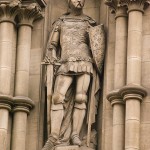To highlight our ever-popular Town Hall tours (11am, every Tuesday, 2.30pm Sundays plus some evenings…meeting at the Midland Hotel…details as of summer 2014), here’s an alphabetical taster…
A
…is for Alfred Waterhouse
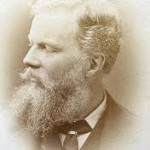 Alfred Waterhouse won the commission to design Manchester Town Hall, which was built between 1868 and 1877. He beat off over 130 competitors including Thomas Worthington (responsible for the Albert Memorial outside the building), and Edward Salomons (the Reform Club on King Street), not just on account of his masterful submission, but through the expert use he made of the site, with its awkward triangular shape, and his ideas regarding light and ventilation.
Alfred Waterhouse won the commission to design Manchester Town Hall, which was built between 1868 and 1877. He beat off over 130 competitors including Thomas Worthington (responsible for the Albert Memorial outside the building), and Edward Salomons (the Reform Club on King Street), not just on account of his masterful submission, but through the expert use he made of the site, with its awkward triangular shape, and his ideas regarding light and ventilation.
The Corporation had given no preference for the building’s architectural style, but to emphasise Manchester’s newly found wealth from textiles Waterhouse chose as his model the 13th century Gothic cloth halls of Flanders, from where weavers had aided the local textile economy in the 14th century.
Waterhouse built in brick faced with stone from the West Yorkshire Spinkwell quarries for the exterior, ashlar for the interior, and placed above the main entrance a 286-foot high clock tower. Inside, Waterhouse’s skill becomes apparent. Seven staircases lead up from the ground floor; some grand and imposing, others spiraling mysteriously at the corners of the building. On the first floor are the Lord Mayor’s rooms, the Conference Hall (the original council chamber), which contains a huge Gothic chimney-piece, oak screen and wrought-iron galleries where the press and public sat, and the Great Hall, the building’s tour de force, which John Ruskin called “the most truly magnificent Gothic apartment in Europe”. In the panels of the Great Hall’s hammerbeam roof are gilded costs of arms of the nations with which Manchester traded, and on the walls are Ford Madox Brown’s 12 murals which illustrate episodes in Manchester’s history.
Below the Great Hall is the atmospheric, ancient-looking courtyard (often used as a Victorian setting in TV dramas), while throughout the profusion of cloister-like corridors, spiral staircases, bridges and stairwells creates a wonderful sense of drama.
Manchester Town Hall is Alfred Waterhouse’s masterpiece. his other great works include Strangeways prison, Manchester university and the Natural History Museum.
***
B
…is for Bee
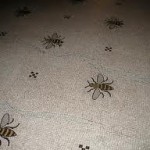 The humble bumble bee is the official Manchester animal. Other cities and countries sport lions and elephants; Manchester the bee. The city is a hive of industry where everyone is as busy as bees. Consequently the meeting area outside the Town Hall’s Great Hall is known as The Bees, the floor decorated with scores of the insect amid the mosaics under the glazed panels of the Mayors and Lord Mayors.
The humble bumble bee is the official Manchester animal. Other cities and countries sport lions and elephants; Manchester the bee. The city is a hive of industry where everyone is as busy as bees. Consequently the meeting area outside the Town Hall’s Great Hall is known as The Bees, the floor decorated with scores of the insect amid the mosaics under the glazed panels of the Mayors and Lord Mayors.
C
…is for Coat of Arms, Council Crest and Cotton
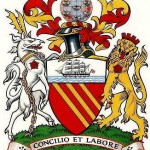 The Manchester Coat of Arms was devised in 1842 following the creation of the borough.
The Manchester Coat of Arms was devised in 1842 following the creation of the borough.
The bees on the globe relate to the bee being the chosen Manchester animal in this hive of industry (see “B is for Bee” above). The ship in full sail records Manchester as a commercial city, trading with the world, linked with the free trade movement of the time. But it was also a mark of wishful thinking on behalf of the city leaders who dreamed of linking Manchester with the sea via a canal – what opened in 1894 as the Manchester Ship Canal.
The antelope and lion are the coat of arms of Henry IV, early 15th century Duke of Lancaster, the first local figure to become king of England. On the lion’s head is a castle, demonstrating Manchester’s origins at Castlefield. The shield is that of the Grelley family, lords of the manor of Manchester in mediaeval times. The three stripes are not a reference to the three local rivers, the Medlock, Irk and Irwell as some sources suggest, for there were four local rivers, the other being the Tib. The three stripes are the Grelleys’ affirmation of the Holy Trinity.
The Latin motto on the Manchester coat of arms is derived from Chapter 37, Sentence 16 of the Book of Ecclesiasticus, one of the Biblical apocrypha, and translated from the Latin means “with diligence and hard work”, although some wags suggest the more partisan and less traditional alternative: “the council is Labour”. The entire phrase reads: “Let reason go before every action and let counsel go before every action”, an appropriate pun.
But C is also for cotton. The whole building is a tribute to the king of shrubs that transformed Manchester’s industry in the 18th century. It was the money from cotton that made Manchester wealthy enough to build a Town hall this grand. consequently the facade of the building resembles the cloth halls of north-western Europe; there is a golden cotton boll, rather than a cross, on top of the church-like spire (the architect, Alfred Waterhouse, mockingly saying “Manchester is worshipping cotton, industry, money, not God”); there are cotton plant decorations inside in the stonework, and on the walls and ceilings; and there are stories of how Manchester became a great cotton-producing centre on the Murals in the Great Hall (see M is for Murals, below).
D
…is for John Dalton
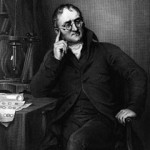 Enter the Town Hall through the main entrance and the first noticeable sight is the two huge statues flanking the hall. They are of scientists: James Prescott Joule and John Dalton. Joule gave his name to the universal unit of heat and energy following his sterling work in the 19th century, but Dalton is the more formidable figure.
Enter the Town Hall through the main entrance and the first noticeable sight is the two huge statues flanking the hall. They are of scientists: James Prescott Joule and John Dalton. Joule gave his name to the universal unit of heat and energy following his sterling work in the 19th century, but Dalton is the more formidable figure.
In a house on George Street, five minutes’ walk from the Town Hall (bombed in the Second World War), Dalton conducted experiments with gases at the turn of the 18th century that changed the world. His atomic theory, published in 1803, suggested the now tacit notion that matter is composed of atoms. The leading British scientists in London had to rethink their views in light of Dalton’s theory. A hundred years later, in Manchester, Ernest Rutherford split the atom, which led to the modern world of atomic power, nuclear bombs and the overhanging threat of Armageddon. This explains why Manchester became Britain’s first nuclear free zone in 1980.
Less controversial was Dalton’s work on colour-blindness, which he suffered from. He published one of the first scientific papers on the affliction; the word for colour-blindness in many European languages includes Dalton’s name. But in English, ironically, we just say colour-blindness.
Dalton’s third great scientific contribution was even more important for Manchester. He kept daily weather records in the city for 57 years and apparently was the first person to explain to locals that it rains here a lot.
E
…is for Edward III
On the Princess Street side of the Town Hall only one statue can be found, that of Edward III, 14th century king of England. Even though Edward probably never came to Manchester, his influence here was considerable. He and his wife, Philippa of Hainault, invited into the North-West weavers from the lowlands where she had been raised. With their skills they gave a significant boost to the local textile economy. Five hundred years later, when the Town Hall was built, Manchester was the world centre for the manufacture and distribution of cotton goods, the new Town Hall itself designed to look like a Flemish cloth hall.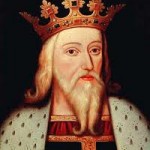 There are other mementos to Edward III in the building. The gorgeously painted ceiling of the entrance hall is decorated with the crest and motto of the Order of the Garter – Dieu et Mon Droit…Honi Soit Qui Mal Y Pense – the foremost order of chivalry in the United Kingdom, found on all government and official buildings. Edward III founded the Order in 1348. He was dancing with his cousin, Joan of Kent, at a ball in Eltham Palace, when her garter slipped. His friends laughed, but the King picked up the fallen garter and placed it on his own leg, turning to his friends with the admonishment Honi Soit Qui Mal Y Pense – shame on he who thinks evil of it.
There are other mementos to Edward III in the building. The gorgeously painted ceiling of the entrance hall is decorated with the crest and motto of the Order of the Garter – Dieu et Mon Droit…Honi Soit Qui Mal Y Pense – the foremost order of chivalry in the United Kingdom, found on all government and official buildings. Edward III founded the Order in 1348. He was dancing with his cousin, Joan of Kent, at a ball in Eltham Palace, when her garter slipped. His friends laughed, but the King picked up the fallen garter and placed it on his own leg, turning to his friends with the admonishment Honi Soit Qui Mal Y Pense – shame on he who thinks evil of it.
Out of this light-hearted moment, the King created a chivalrous Order, to teach his knights a lesson in chivalry. It is still of the highest status, its members now including John Major and Margaret Thatcher. One of the first hand-picked knights was Henry the Good, whose statue can be seen on the outside of the building and at the back of the reception area opposite the entrance hall.
F
…is for Fleur-de-lys
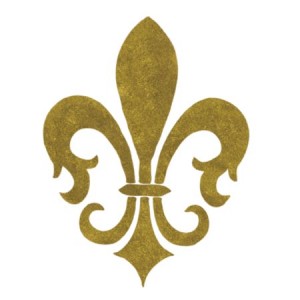 F is also for Freemasons, the secret ritualistic society whose origins date back to Biblical times, created to guard secrets about geometry, religious and architecture. Alfred Waterhouse, architect of the Town Hall, was a member. (It would have been impossible to win the commission to build it had he not been).Waterhouse spread Masonic symbolism around the building. The sun face on the clock, where there should be a 3, 6, 9 and 12, is the Masonic symbol for truth; to boast that the clock is telling the true time. The bee imagery adopted by Manchester in 1842 fitted in perfectly with Waterhouse’s use of symbolism. The beehive is a perfect geometric structure and its constituent elements can be found on the decoration of the floor of the entrance hall.
F is also for Freemasons, the secret ritualistic society whose origins date back to Biblical times, created to guard secrets about geometry, religious and architecture. Alfred Waterhouse, architect of the Town Hall, was a member. (It would have been impossible to win the commission to build it had he not been).Waterhouse spread Masonic symbolism around the building. The sun face on the clock, where there should be a 3, 6, 9 and 12, is the Masonic symbol for truth; to boast that the clock is telling the true time. The bee imagery adopted by Manchester in 1842 fitted in perfectly with Waterhouse’s use of symbolism. The beehive is a perfect geometric structure and its constituent elements can be found on the decoration of the floor of the entrance hall.G
…is for Great Abel
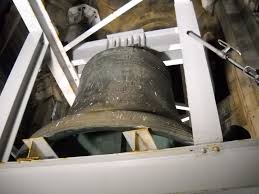 Great Abel weighs 8 tons 2.5 cwt and is the eighth biggest bell in the country, having been recently surpassed by the 2012 Olympic bell. Cast at John Taylor’s of Loughborough, it was ready for the opening of the Town hall in September 1877, but within five years had developed a serious fault – “it now hangs cracked and useless” as one contemporary report put it – and had to be recast.The bell is inscribed with the initials A. H., after Abel Heywood, and a line from the poem “Ring out the false, ring in the true” by Alfred Lord Tennyson, favourite poet of the pre-Raphaelites whose mentor, Ford Madox Brown, painted the Town Hall Murals.
Great Abel weighs 8 tons 2.5 cwt and is the eighth biggest bell in the country, having been recently surpassed by the 2012 Olympic bell. Cast at John Taylor’s of Loughborough, it was ready for the opening of the Town hall in September 1877, but within five years had developed a serious fault – “it now hangs cracked and useless” as one contemporary report put it – and had to be recast.The bell is inscribed with the initials A. H., after Abel Heywood, and a line from the poem “Ring out the false, ring in the true” by Alfred Lord Tennyson, favourite poet of the pre-Raphaelites whose mentor, Ford Madox Brown, painted the Town Hall Murals.H
…is for Abel Heywood
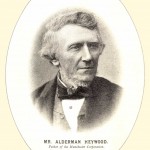 The Queen was advised not to appear on the same platform as Heywood because in his younger days he had been fined and even gone to jail for refusing to pay the stamp duty tax on his newspaper the Poor Man’s Guardian, a publication for which he had won the Manchester franchise, which carried articles advocating the overthrowing of the monarchy and its replacement in Britain with a republic. The fine of £48, which he refused to pay, leading to a jail sentence, didn’t prevent his bookselling business on Oldham Street thriving or stop his radical political activities – his support for Chartism and Manchester’s incorporation.By the 1870s, Heywood was a pillar of the establishment and a Liberal councillor, but the Queen’s advisors were wary of the monarch appearing on the same platform as an ex-jailbird with republican sympathies. Despite his heroic status in many Manchester circles, Heywood might however have walked around on feet of clay, as in Nebuchadnezzar’s dream. In April 1840 he had been prosecuted for blasphemy yet received only a suspended sentence. Correspondence involving the police and the Home Office has since revealed that Heywood might have received a lighter punishment in exchange for informing the police of a Chartist rising that was talking place in Bolton.
The Queen was advised not to appear on the same platform as Heywood because in his younger days he had been fined and even gone to jail for refusing to pay the stamp duty tax on his newspaper the Poor Man’s Guardian, a publication for which he had won the Manchester franchise, which carried articles advocating the overthrowing of the monarchy and its replacement in Britain with a republic. The fine of £48, which he refused to pay, leading to a jail sentence, didn’t prevent his bookselling business on Oldham Street thriving or stop his radical political activities – his support for Chartism and Manchester’s incorporation.By the 1870s, Heywood was a pillar of the establishment and a Liberal councillor, but the Queen’s advisors were wary of the monarch appearing on the same platform as an ex-jailbird with republican sympathies. Despite his heroic status in many Manchester circles, Heywood might however have walked around on feet of clay, as in Nebuchadnezzar’s dream. In April 1840 he had been prosecuted for blasphemy yet received only a suspended sentence. Correspondence involving the police and the Home Office has since revealed that Heywood might have received a lighter punishment in exchange for informing the police of a Chartist rising that was talking place in Bolton.I
…is for Independence
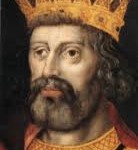 Henry symbolises political independence. Under his rule in the 13th century England held its first Parliament. Henry had to be persuaded considerably to give this concession, but it meant that for the first time the people, albeit only a few of them, had some say in how the country was run. Manchester prides itself as harbouring the soul of Parliamentary democracy. It was in Manchester, only a few minutes walk from where the Town Hall now stands, that people lost their lives in 1819 demonstrating for the right to vote in what became known as the Peterloo Massacre.
Henry symbolises political independence. Under his rule in the 13th century England held its first Parliament. Henry had to be persuaded considerably to give this concession, but it meant that for the first time the people, albeit only a few of them, had some say in how the country was run. Manchester prides itself as harbouring the soul of Parliamentary democracy. It was in Manchester, only a few minutes walk from where the Town Hall now stands, that people lost their lives in 1819 demonstrating for the right to vote in what became known as the Peterloo Massacre.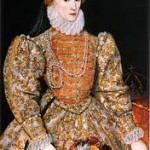 Henry III never visited Manchester. Nor did Elizabeth I whose presence outside the Town Hall symbolises religious independence. In the 1570s Elizabeth ordered the closure of the Catholic college of priests that still stands by Victoria Station, now as Chetham’s school and library, and its refounding as a Protestant establishment – Christ’s College, Manchester.The politicians and merchants who built Manchester Town Hall in the 1860s and 1870s were Liberals politically, keen to take pride in their support for Parliamentary democracy, hence the statue of Henry who presided over the first Parliament. In religion, their views were anti-Catholic, staunchly Protestant and noncomformist, hence their homage to Elizabeth.
Henry III never visited Manchester. Nor did Elizabeth I whose presence outside the Town Hall symbolises religious independence. In the 1570s Elizabeth ordered the closure of the Catholic college of priests that still stands by Victoria Station, now as Chetham’s school and library, and its refounding as a Protestant establishment – Christ’s College, Manchester.The politicians and merchants who built Manchester Town Hall in the 1860s and 1870s were Liberals politically, keen to take pride in their support for Parliamentary democracy, hence the statue of Henry who presided over the first Parliament. In religion, their views were anti-Catholic, staunchly Protestant and noncomformist, hence their homage to Elizabeth.
J
…is for John Bright
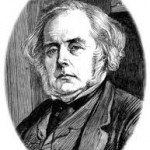 It’s a close call between William Gladstone and John Bright as to who is honoured more in and around the Town Hall. Both of these towering 19th century figures have statues in Albert Square, in the Town Hall Sculpture Hall area and upstairs. Although Gladstone, four times prime minister, can be found in the Great Hall, John Bright has an even grander, greater statue on the stairs leading to the state rooms.Bright was a local figure who powerfully represented Manchester as Liberal MP in the mid-19th century. His policies were pro-religious freedom, anti-slavery, against capital punishment and flogging in the Army, and pro-free trade; that prices should be set by the merchants, not the Government, a stand which would nowadays see him derided as a “Thatcherite”, but was then opposed by the Conservatives.He was also in favour of peace. Of course all politicians claim to support peace, but Bright vigorously opposed the Crimean War of the 1850s even though it cost him his seat. As he told the House on 23 February 1855: “The angel of death has been abroad throughout the land. You may almost hear the beating of his wings.” John Bright goes down in history as a statesman, rather than merely as a politician, someone whose authority and influence outstripped partisan politics.
It’s a close call between William Gladstone and John Bright as to who is honoured more in and around the Town Hall. Both of these towering 19th century figures have statues in Albert Square, in the Town Hall Sculpture Hall area and upstairs. Although Gladstone, four times prime minister, can be found in the Great Hall, John Bright has an even grander, greater statue on the stairs leading to the state rooms.Bright was a local figure who powerfully represented Manchester as Liberal MP in the mid-19th century. His policies were pro-religious freedom, anti-slavery, against capital punishment and flogging in the Army, and pro-free trade; that prices should be set by the merchants, not the Government, a stand which would nowadays see him derided as a “Thatcherite”, but was then opposed by the Conservatives.He was also in favour of peace. Of course all politicians claim to support peace, but Bright vigorously opposed the Crimean War of the 1850s even though it cost him his seat. As he told the House on 23 February 1855: “The angel of death has been abroad throughout the land. You may almost hear the beating of his wings.” John Bright goes down in history as a statesman, rather than merely as a politician, someone whose authority and influence outstripped partisan politics.K
…is for Ken Strath

